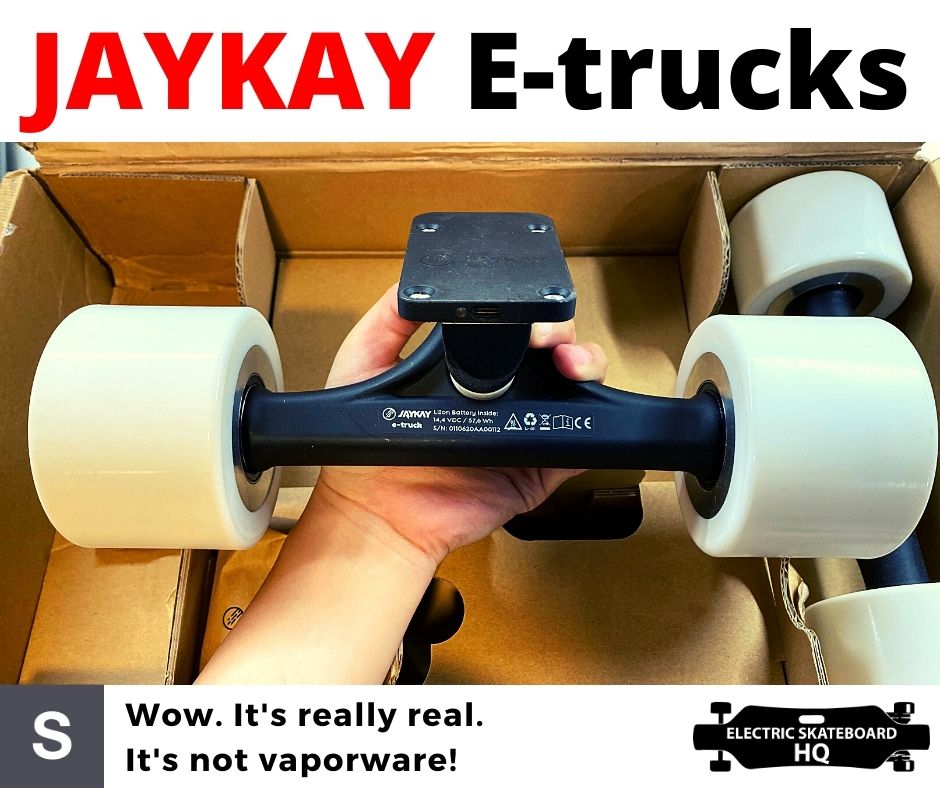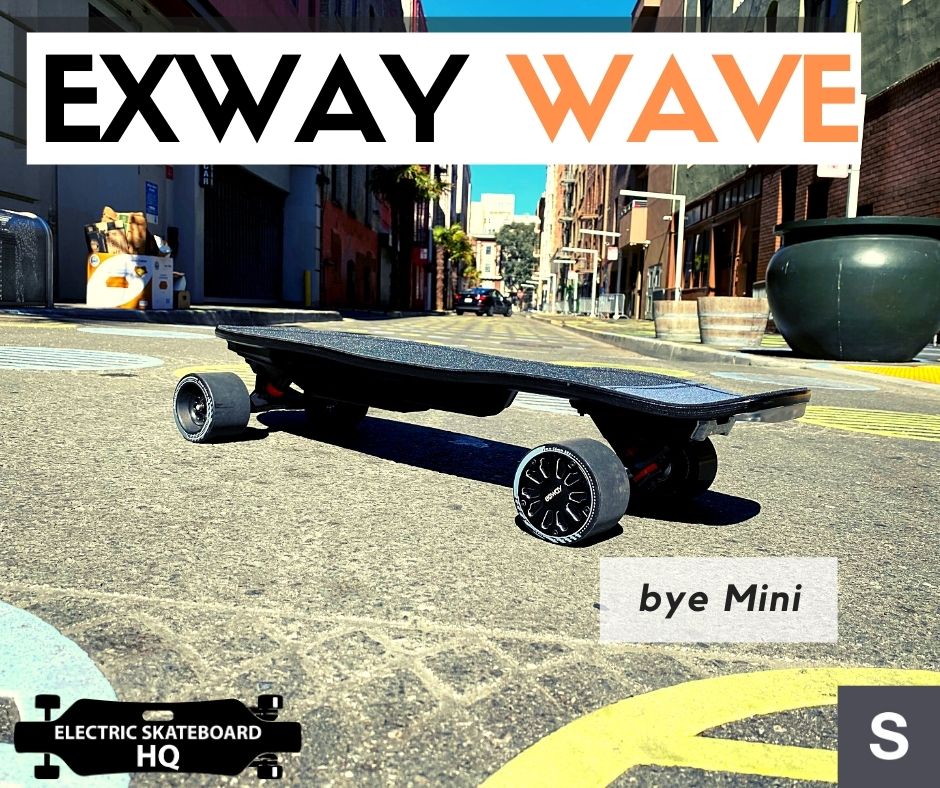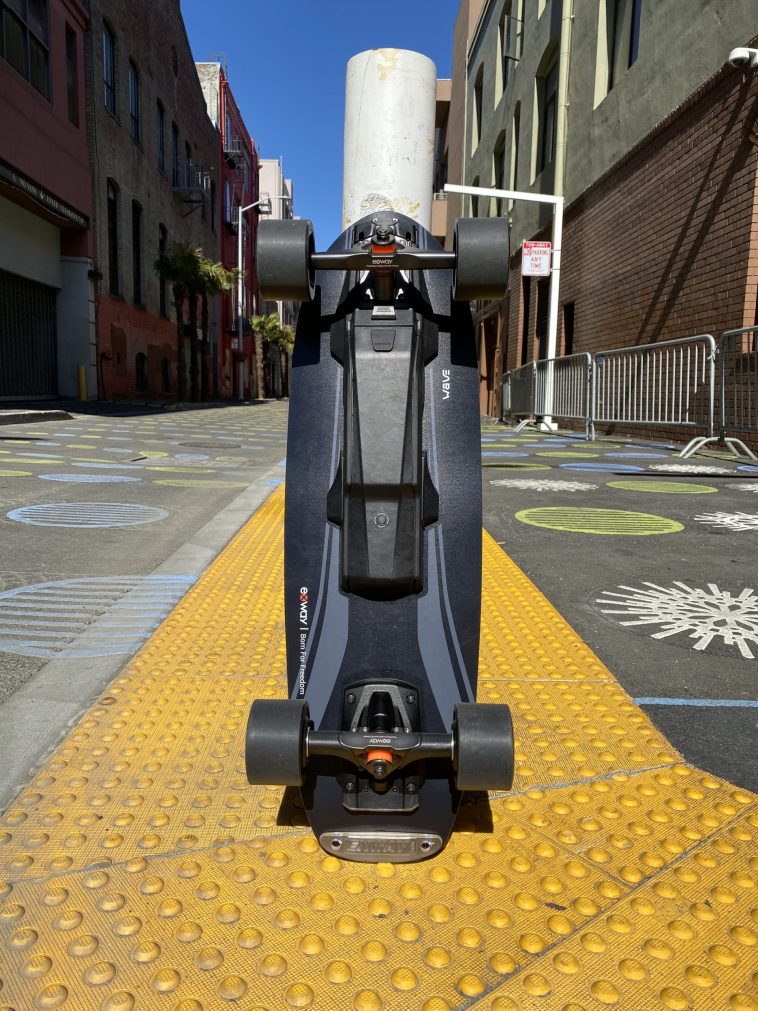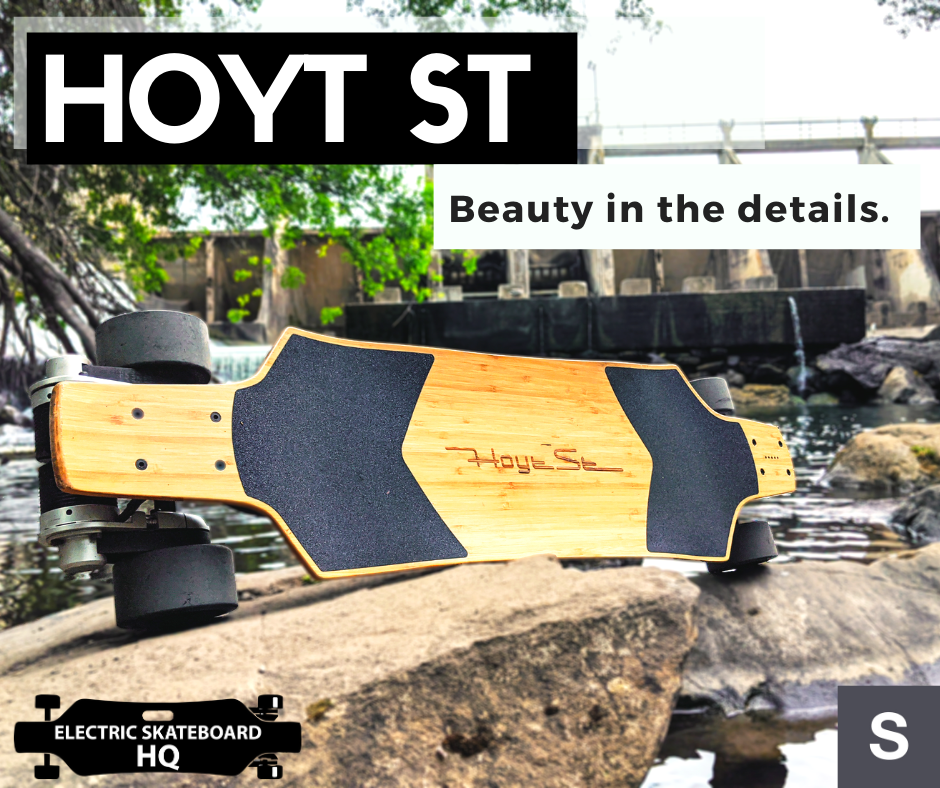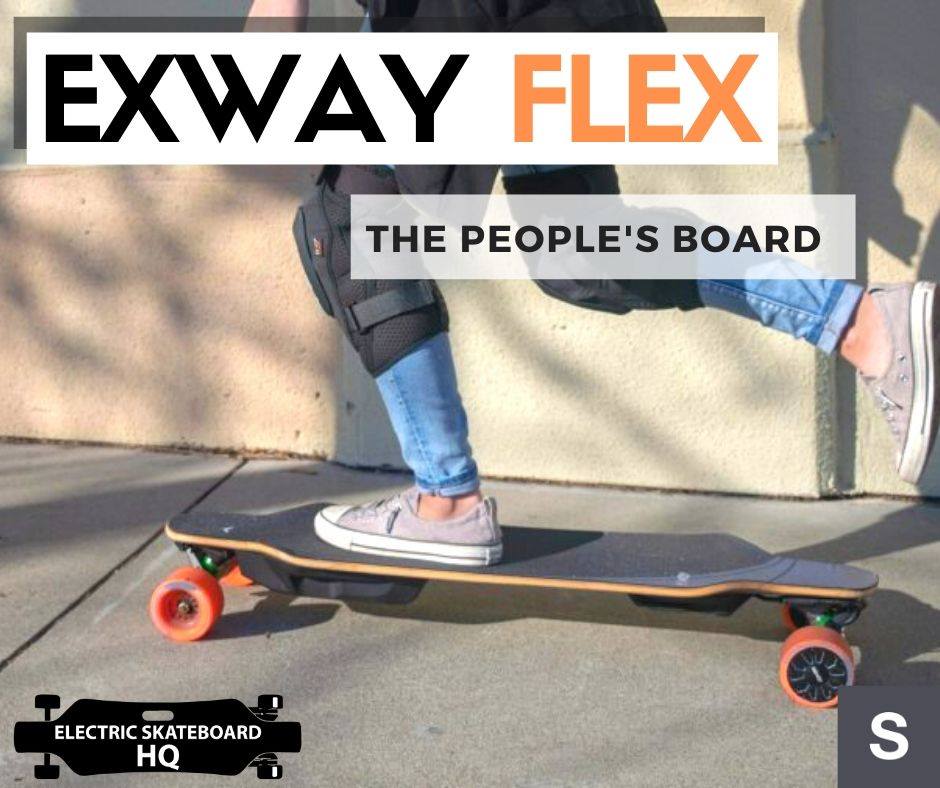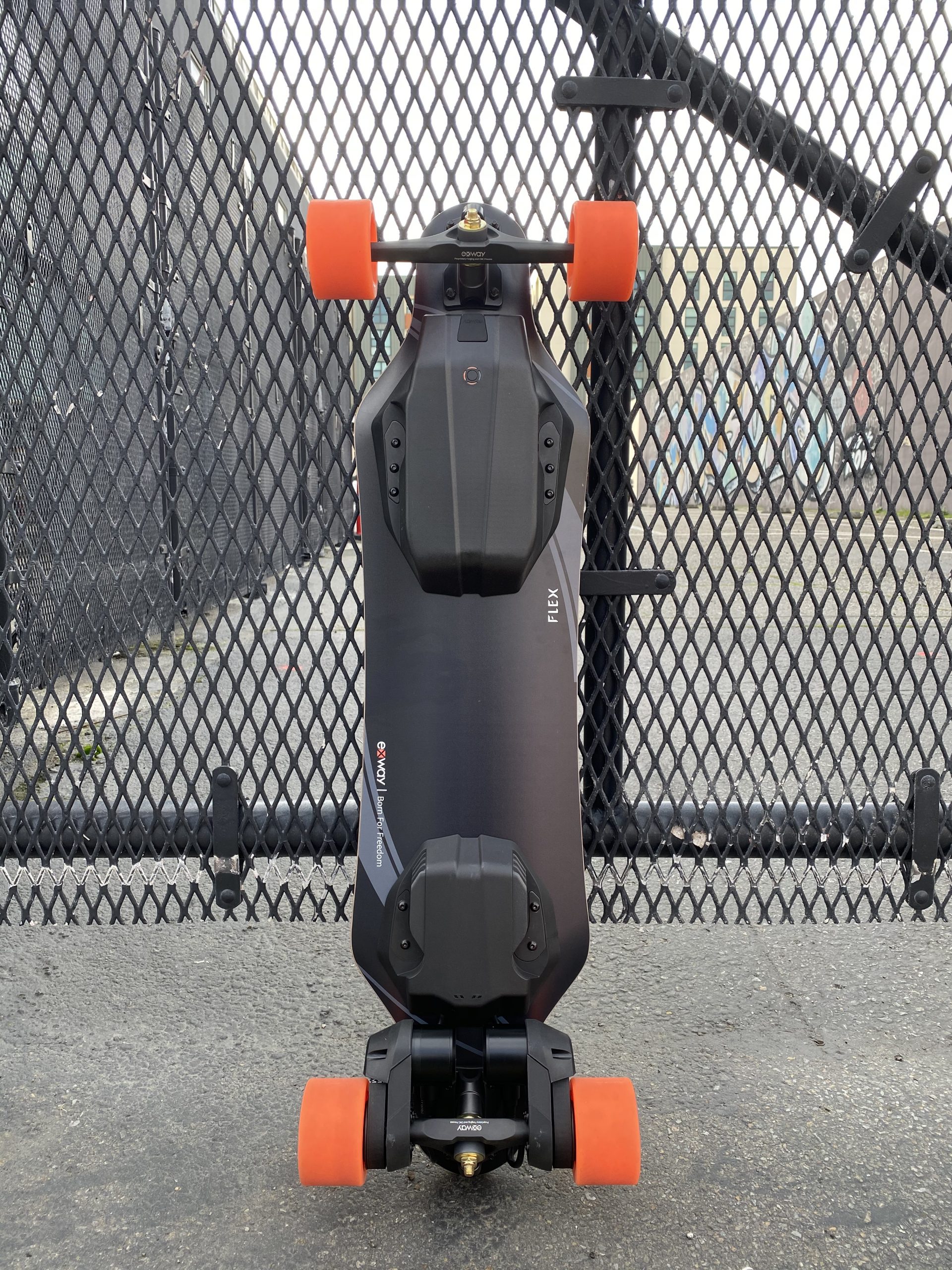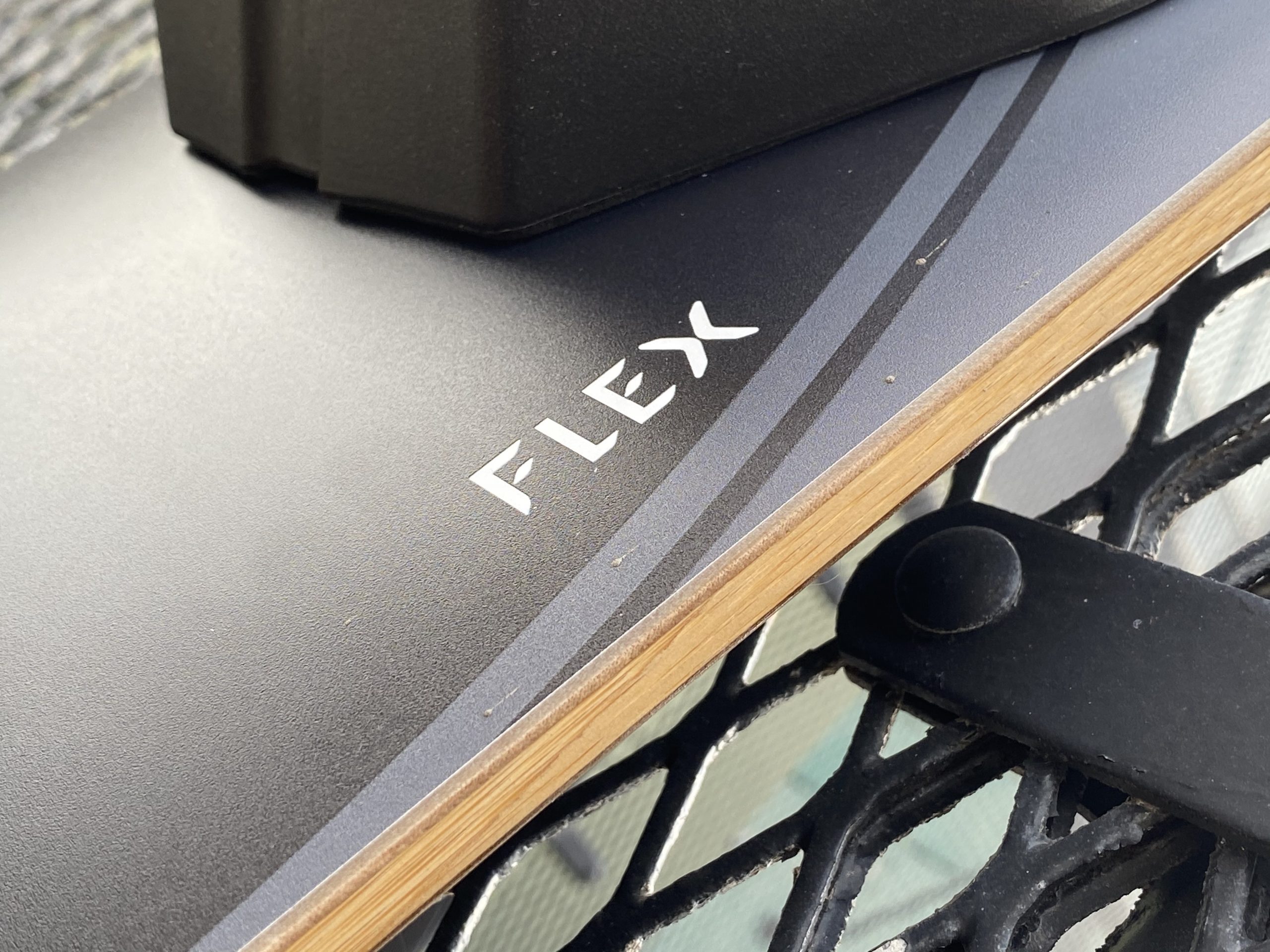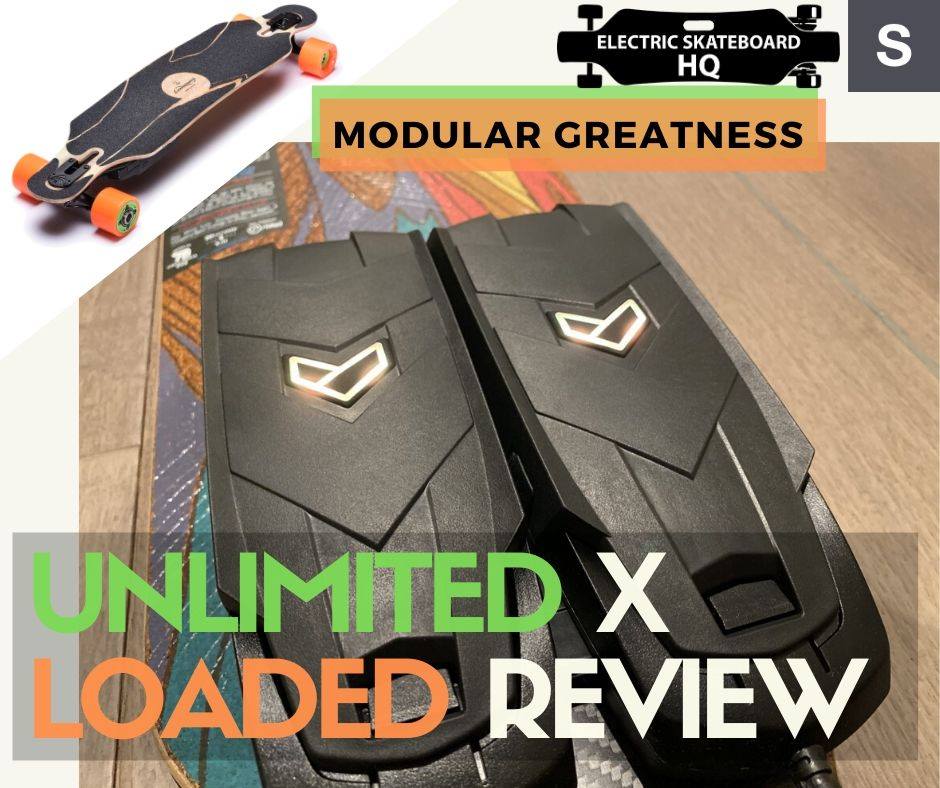Oh man… where do I begin with the JayKay e-trucks?
I guess the best place to start would be to explain what they are. The JayKay e-truck is a reverse kingpin longboard truck that has a bunch of electronics stuffed inside the baseplate and hanger. The truck links with a ring shaped remote with a thumbwheel and tiny display from which you can control acceleration and braking easily. JayKay sells these trucks in 2wd and 4wd options, though they recommend the 4wd option.
What this means is you can turn any deck into an electric skateboard with absolutely zero (0) modification. This, in turn, means total freedom of choice and ride. I love it. This is totally the fut– well let me back up to the beginning.

lol jk
I remember where I was when I first heard about JayKay. The year was 2017, the month was March, and I was sitting at home, reading a curious thread on the electric-skateboard.builders forum about an eskate Kickstarter from a company based out of Germany, JayKay Sports. The thread was mean. The people in it were tearing the Kickstarter apart and claiming that the trucks were “Grade A+ bull shit”.

I’ll admit, I was highly skeptical as well. Everything inside a truck? 7 mile range? Super tiny remote? Charging via USB-C? Zero-resistance hub motor with zero cogging? Sounds like somebody just took all the pipe dreams of an eskater and chucked them in one place! So I closed out of the thread and forgot all about it.
Until 2020.
I was vacationing in Taipei, Taiwan with my boyfriend and linked up with the Taiwan eskate group, Esk8 4Ever. It’s always fun to find like minded people when you travel, and the Esk8 4Ever peeps were definitely fun. At some point during our visit, we met up at a board shop (one of the best ever, possibly in the world, I might add. Amgreat Integration. Definitely visit.) and one of the chaps, Cheng Li-Wei, asked if we wanted to see something very curious that he’d just received from Germany. Of course we were interested, and thus was my first time seeing the JayKay e-trucks in person.








“Wow. It’s really real. It’s not vaporware,” I remember thinking. The next thing that blew me away was the remote. So small and unassuming! How the heck did they manage to fit a display and Type C charging onto a ring that small? Then I rode the thing. What the heck there’s actually a decent amount of torque? What the heck zero resistance in the motors? What the heck zero cogging? What the heck’s going on?
I think it’s safe to say I was immediately and totally infatuated. Flexible enough to mount anywhere? Unobtrusive enough to be virtually unnoticeable? It’s like a cruiser’s wet dream! I immediately hit up my editor Paxson to see if he could get us a review unit to put through the test.
This is where a damper gets put on my hopes and dreams. It turns out that JayKay was generally unwilling to send out review units even though we only wanted to borrow them. We had to buy our own unit. Ok sure, no problem, we’re willing to buy review units in the name of the truth. So we bought a 4wd kit.
But then the wait began. What made the wait worse was that JayKay was not super communicative. Nevertheless, we persevered, and four months (almost to the day) later, an unassuming box arrived in my mailroom.
All it had on the outside was a shipping label, but that was enough. I read the return address. “JayKay”. Suddenly I was a kid again.
A Masterclass In Miniaturization
I was unreasonably excited opening the box. I had absolutely no idea what all would come in the box, but I wasn’t disappointed. The JayKay 4wd kit contains two trucks, one remote, a three port (2 x Type C PD, 1 x Type C QC3) charger, two magnetic Type C cables, one regular Type C cable (all of them braided), and a cool skate tool.









I think the most striking thing about the e-trucks is just how unassuming everything is. There’s no fancy design at all. The wheels it ships with are plain white. 90mm, with just the tiniest amount of sans serif text on the side. The hangers themselves are completely matte smooth with “JayKay” embossed on the front. The baseplate barely hints at the USB Type C PD charging port and LED headlight it contains. You’d be forgiven if you just wrote it off as a regular truck.

But what you don’t see is the masterclass in component miniaturization that is taking place inside each truck. A dual motor speed controller, encased in its own faraday cage, runs along the length of the truck, which also doubles as its heatsink. Four Samsung 40T 21700 cells take up most of the space inside, directly wired into the four layer pcb of the speed controller for minimal power losses due to resistance in longer wires. The motor controller actively switches between drawing in 4S1P or 2S2P configuration from the battery in order to optimize reduction of internal losses.
All this tech in the truck then communicates via powerline using a system of pogo pins in the pivot cup to the components in the baseplate that handles wireless connection, lights, charging, etc. It honestly confounds me how much tech and new ideas they’ve managed to pack in there.


Drivetrain Madness
The motors themselves are no joke either. A totally new design that JayKay’s motor engineer spent five years researching and developing for his PhD, it’s a total outlier in the current-day motor game.
The first thing you’ll notice is that these hubs have almost no rolling resistance and no cogging. It’s exactly as if you’re riding a regular skate wheel. This is due to the ironless stator and air-gapped windings JayKay has developed versus the typical iron-filled, slotted stators used nowadays with most common outrunner motors.
I will say, at 160kv and 90mOhm winding resistance, this isn’t the most efficient motor out there, but I think the real world results speak for themselves for JayKay better than the pure numbers.


Because of this novel motor design, there are no motor factories that can make this type of motor. So JayKay has to build each motor in-house, with tooling that they also built in-house, essentially hand winding each motor. It’s not exactly a fast process, and it shows in their delivery rate. Having heard Li-Wei’s story and having experienced quite a long wait time myself despite JayKay knowing I was a reviewer, I can confirm that you won’t exactly get your trucks fast, though they eventually did deliver.
UX Curiosity
I think it’s worth talking in depth about JayKay’s UX with their e-trucks as it’s certainly one of the more… unique things about the whole experience.
JayKay has opted to go all in on energy saving. They have to. Cause in comparison to basically anything else, the battery packs in these trucks are absolutely tiny. So in order to make the batteries last as long as possible on a charge, JayKay has implemented a bunch of energy saving quirks into their software.
For example, you must push off every time after you stop to turn the trucks on. This means no standing takeoffs on any sort of incline or flat ground. And if you let the remote sit without throttling for more than 2 minutes, you must click the thumbwheel to turn it on again. Also, there’s no “forward” direction. Whichever way you push off will become forwards. All this becomes second nature when you get used to it of course, but for the first while of usage, I kept on forgetting that I had to click and push after stopping at every stoplight.
JayKay has also opted to include other interesting features as well. For example, there’s an LED headlight and taillight integrated into each baseplate. It’s not really very bright so I feel like it’s a bit of a battery waster (I keep them turned off) but they’re there nevertheless.
Another interesting “feature” is that the battery is user swappable by just popping off a motor. I think this is more of a you can do it feature vs a definitely intended feature, but it’s there. I haven’t tried it. Yet another interesting feature is a wireless charging coil in the baseplate that can also do reverse wireless charging for devices, though JayKay tells me this will be for V2 and is not currently present in V1. It’s worth noting the instruction manual also mentions an app but JayKay tells me it’s also not out yet.
The One Ring
Of course, having only mentioned it only briefly so far, I must talk about the remote.





JayKay’s ring remote is a huge departure from the norm, and honestly I’m a fan.
It’s super small and wraps around your finger, just like a ring. There’s a spring-loaded section that grips your finger lightly so it doesn’t slip around too much and can adjust to various finger thicknesses. A bright, OLED display shows information like speed, battery level, power mode, and current charge, though I think it doesn’t update at a very high frequency because the speed indicator doesn’t change very fast.
I haven’t had any cutouts or disconnects on this remote, and I live in a fairly wirelessly dense area. That’s encouraging to me. The remote also has a signal strength indicator, though I don’t know if it takes into account interference. I haven’t been able to take it to any of the places where I can regularly get less capable remotes to cut out (mostly due to range) but so far my tests have shown that it’s doing fairly OK.
I suppose the most important thing that I must mention about this remote is the general user experience. In an effort to save power consumption, JayKay is very aggressive with its standby timer. This means that the remote and board goes into standby fairly often as the standby timer on the board is somewhere around half a minute and two minutes with the remote.
I’m not gonna lie, the standby timers catch me unawares quite a lot. A general flow of my interactions is as follows:
- Reach a stop at a stoplight.
- Stand for a couple minutes.
- The board goes into standby.
- The remote goes into standby soon after.
- I push off when the light turns green… but forget to click the remote so there’s no immediate power.
I don’t think this is really a usability issue, just a gotta-adjust issue. I understand where they’re coming from with the very eager auto-standby’s, I just have to get used to clicking the remote when I take off is all.
It’s worth mentioning that clicking the wheel while the remote is on doesn’t do anything. All menu actions are hidden behind a long click, so rest assured you won’t accidentally change anything if you click while the remote is not on standby mode.
Powerrrrrr…?
Now we must talk about power.
I would say that there is… enough? Look, you’re not getting this thing to go 30mph and rocket up hills. I think you should think of this more like an assist rather than a full eskate, as that’s clearly the direction they’ve gone in here. The whole point is to cruise, maybe kick a bit, and cruise some more. If you wanna have just a tiny bit more fun, you can certainly turn up the power mode to “huge muscle” and go full throttle, but I don’t think it’s very different from “big muscle” or even “small muscle” mode during regular riding. It only matters for hills and stuff.

During range tests, I was able to squeeze more than expected range out of them. I tend to average around 5 miles or so at a cruising speed, which is honestly more than I expected. This includes going up and down higher grade hills and starting/stopping, which tends to kill batteries faster. For reference, I’m around 130-135lb.

Which brings me to torque. It certainly has it (I tested the 4wd kit) and I can go up hills just fine (though not fast), but I encountered some interesting behavior.
The JayKays are set up so that if you step off while the board is rolling, the board will brake. It’s a great idea, but in some instances, I’ve had that feature slightly backfire on me. When going uphill and going over an extreme pothole, the truck going over the pothole will slightly brake then resume powering. It’s a bit jarring as it feels like a momentary loss in power, and makes me wish there was a way to turn off the auto braking. Regularly though, it doesn’t happen when just cruising, and I think the extremely pot-holey hills I’ve got here are the exception, not the norm.
Also sometimes, if I take off hard from almost a dead stop, I can feel the trucks start powering slightly out of sync at first. Not always, but sometimes. What usually happens in these instances is one of them will start powering, then a fraction of a second later, the other one will kick in. It’s not really a big deal, just a quirk that I’ve found, but certainly something to keep in mind when bracing for harder takeoffs.
There’s also the issue of overheating. A couple times going up steep, extended stretches of hills, the remote starts warning me that the trucks were overheating. This isn’t something completely unexpected as most times when I’ve felt the trucks after riding they were almost always hot, but just another limitation to consider before purchasing. I can just about manage in San Francisco and there really aren’t a whole lot of places hillier than it is here, but if you’re in one of those places, I’d recommend you think hard about what you’re looking for in these trucks.

Konnichiwa Wildhearts
Honestly, it’s so refreshing to take a break from reviewing “yet another” eskate. The JayKay e-trucks may not go very far or very fast, but they’re something special. Cutting edge yet distinctly old school feeling at the same time. I don’t think I’ve ever felt anything like it.
I don’t wanna be in love with the future, yet I am. And I love it.
A Note From Paxson (The Editor):
If you liked this review and are interested in buying the JayKay e-trucks yourselves, please support us by using our affiliated link here.




